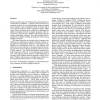Free Online Productivity Tools
i2Speak
i2Symbol
i2OCR
iTex2Img
iWeb2Print
iWeb2Shot
i2Type
iPdf2Split
iPdf2Merge
i2Bopomofo
i2Arabic
i2Style
i2Image
i2PDF
iLatex2Rtf
Sci2ools
AUIC
2005
IEEE
2005
IEEE
Evaluation of Two Textual Programming Notations for Children
Many researchers have developed many programming environments for children. Typically each of these environments contains its own programming notation ranging from computer code to animated virtual 3D robots and in some case the notation consists of physical objects. While some of these notations were created by examining how children naturally describe computer programs, little research has examined how children understand programs written using these notations. Even less research has examined how children understand programs written using multiple notations. This paper describes an evaluation that compares how children can understand computer programs written using different programming notations: conventional code, English, or a combination of the two. The children were about eleven years old and we measured speed in answering questions about computer programs and the accuracy of their answers. We found that children reading computer programs written in a conventional-style notatio...
AUIC 2005 | Children Understand Programs | Multiple Notations | Programming Notations | Software Engineering |
| Added | 24 Jun 2010 |
| Updated | 24 Jun 2010 |
| Type | Conference |
| Year | 2005 |
| Where | AUIC |
| Authors | Timothy N. Wright, Andy Cockburn |
Comments (0)

